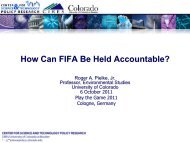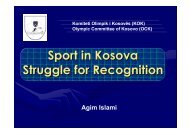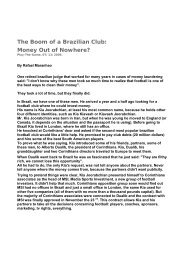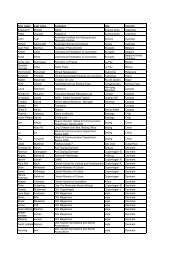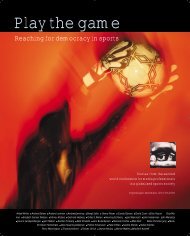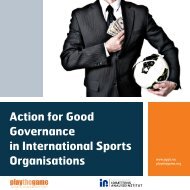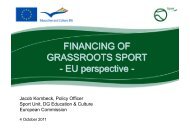Traditional games: A joker in modern development ... - Play the Game
Traditional games: A joker in modern development ... - Play the Game
Traditional games: A joker in modern development ... - Play the Game
Create successful ePaper yourself
Turn your PDF publications into a flip-book with our unique Google optimized e-Paper software.
Paper for <strong>the</strong> <strong>in</strong>ternational conference <strong>Play</strong> <strong>the</strong> game, Copenhagen, November 2005.<br />
<strong>Traditional</strong> <strong>games</strong>: A <strong>joker</strong> <strong>in</strong> <strong>modern</strong> <strong>development</strong>.<br />
Some experiences from Nordic countries and Nordic-African exchange<br />
Henn<strong>in</strong>g Eichberg<br />
University of Sou<strong>the</strong>rn Denmark, Centre for Sport, Health and Civil Society, Gerlev<br />
Contents<br />
Sport <strong>development</strong> aid Scand<strong>in</strong>avia-Tanzania: top-down and bottom-up<br />
From sport export to popular culture exchange<br />
<strong>Traditional</strong> <strong>games</strong> <strong>in</strong> <strong>the</strong> Nordic countries: identity, relic, <strong>development</strong><br />
The <strong>development</strong>al functionalism of sports<br />
Ano<strong>the</strong>r <strong>development</strong>: traditional <strong>games</strong> promoted by ‘Sport for All’<br />
Popular movements, identity, and social <strong>in</strong>dignation: <strong>games</strong> developed from below<br />
Old <strong>games</strong> as new <strong>games</strong>: ‘We talk – you listen’<br />
______________________________<br />
Abstract<br />
The <strong>development</strong> of sport and its contribution to <strong>the</strong> <strong>development</strong> of society as a whole is not<br />
a movement <strong>in</strong>to one direction only, go<strong>in</strong>g from traditional <strong>games</strong> to <strong>modern</strong> sport.<br />
Experiences from Scand<strong>in</strong>avian <strong>development</strong> aid show a much more complex picture of<br />
exchanges between popular sports <strong>in</strong> Denmark and ngoma dance <strong>in</strong> Tanzanian. Also <strong>in</strong>side<br />
<strong>the</strong> Nordic countries, traditional <strong>games</strong> are rediscovered <strong>in</strong> <strong>the</strong> context of educational and<br />
socio-cultural <strong>development</strong>. In contrast to <strong>the</strong> established <strong>the</strong>ory of <strong>development</strong>al<br />
functionalism, which is argu<strong>in</strong>g top-down, sport <strong>development</strong> can also mean exchange and<br />
empowerment of <strong>the</strong> people, bottom-up. Development is <strong>development</strong>s <strong>in</strong> plural. ‘Old’ <strong>games</strong><br />
reappear<strong>in</strong>g as new <strong>games</strong>, challenge <strong>the</strong> established categories of ‘forward’ and ‘backward’<br />
<strong>in</strong> history. To <strong>the</strong> experts of <strong>the</strong> Western sport, <strong>the</strong> <strong>games</strong> say: ‘We talk – you listen.’<br />
______________________________<br />
Once upon a time, <strong>the</strong> <strong>development</strong> of sports looked like one s<strong>in</strong>gle path lead<strong>in</strong>g from<br />
traditional <strong>games</strong> to <strong>modern</strong> sport. Just like ‘<strong>the</strong> evolution’ of society was imag<strong>in</strong>ed as a oneway<br />
transformation from tradition to <strong>modern</strong>ity.<br />
Today, <strong>the</strong> narrative of <strong>the</strong> one way is still quite liv<strong>in</strong>g, constitut<strong>in</strong>g a<br />
fundamental myth of Western self-understand<strong>in</strong>g. And <strong>in</strong>deed, it <strong>in</strong>cludes some important<br />
truth (Guttmann 2004: 285). However, <strong>the</strong> narrative of <strong>the</strong> one way may also sound like a<br />
touch<strong>in</strong>g fairy tale from past time. This tale relieves from all those <strong>in</strong>ner contradictions,<br />
which ‘<strong>the</strong> progress’ has produced for <strong>modern</strong> life. There are contrast<strong>in</strong>g experiences<br />
worldwide.<br />
Sport <strong>development</strong> aid Scand<strong>in</strong>avia-Tanzania: top-down and bottom-up<br />
Let us turn to a special focus area of Danish <strong>development</strong> aid, Tanzania. The Tanzanian case<br />
has also played a special role for Scand<strong>in</strong>avian sport <strong>development</strong> aid.<br />
Scand<strong>in</strong>avian <strong>development</strong> aid to sports <strong>in</strong> Tanzania was from <strong>the</strong> beg<strong>in</strong>n<strong>in</strong>g<br />
characterized by <strong>in</strong>ner contradictions. These conflicts did not only result from <strong>the</strong> tension<br />
between mass sports and elite sports, where West German policies constituted a contrast<strong>in</strong>g<br />
model by send<strong>in</strong>g top tra<strong>in</strong>ers for <strong>the</strong> national team of soccer and o<strong>the</strong>r elite sports to <strong>the</strong><br />
African country. The strategy of mass sports or Sport for all could be contradictory, too.<br />
1
Some Scand<strong>in</strong>avian projects of <strong>the</strong> 1980s supported <strong>the</strong> construction of a national sport<br />
adm<strong>in</strong>istration – under “sport officers” who formed a new hierarchy under <strong>the</strong> central<br />
government of <strong>the</strong> (at that time) one-party state. And Scand<strong>in</strong>avians launched sport activities<br />
of Western style by sport-ware export.<br />
The ma<strong>in</strong> project, which started from <strong>the</strong> Swedish side, was titled Idrott åt alla –<br />
även i Tanzania (Sport for all – even <strong>in</strong> Tanzania). Used sports requisites and discarded sport<br />
outfits were collected among Nordic clubs, put <strong>in</strong>to conta<strong>in</strong>ers, and sent down to Dar Es<br />
Salaam to be distributed <strong>in</strong> <strong>the</strong> region of Arusha. The project started by a great success and<br />
visibility, with <strong>the</strong> Tanzanian m<strong>in</strong>ister of sports open<strong>in</strong>g <strong>the</strong> arrangement <strong>in</strong> <strong>the</strong> stadium of<br />
Arusha <strong>in</strong> August 1983. Courses for tra<strong>in</strong>ers, leaders and teachers were connected to <strong>the</strong><br />
distribution of material. But soon, <strong>the</strong> reverse of <strong>the</strong> <strong>in</strong>itiative became visible. Many sport<br />
shoes were old and worn out, balls were pegged out. The smart jogg<strong>in</strong>g dresses found some<br />
illegal ways to wealthier people <strong>in</strong> <strong>the</strong> town. Conta<strong>in</strong>ers were broken up, and one jogger,<br />
suspected of <strong>the</strong>ft, though <strong>in</strong>nocent, was shot by <strong>the</strong> police. Children were sent to jogg<strong>in</strong>g <strong>in</strong><br />
<strong>the</strong> roads of Arusha, offer<strong>in</strong>g <strong>the</strong>m Swedish ski caps, which did not at all fit to <strong>the</strong> climate of<br />
<strong>the</strong> region. F<strong>in</strong>ally, <strong>the</strong> best of <strong>the</strong> sports-wares were canalised <strong>in</strong>to a sports-ware shop sell<strong>in</strong>g<br />
<strong>the</strong>m to <strong>the</strong> best-pay<strong>in</strong>g strata. Some sports officers began to manipulate <strong>the</strong> f<strong>in</strong>ancial means<br />
of <strong>the</strong> courses and <strong>the</strong> distribution of <strong>the</strong> sport-wares. In 1989, <strong>the</strong> project was closed down,<br />
and with this closure, all effects of <strong>the</strong> project disappeared from <strong>the</strong> region. What had started<br />
by <strong>the</strong> <strong>in</strong>tention of good-will, produced ill-humour on <strong>the</strong> Tanzanian side, though, it is true,<br />
also some impressive statistics for <strong>the</strong> world of Swedish sports. Development aid affirmed <strong>the</strong><br />
colonial one-way unbalance – ‘we <strong>the</strong> rich give to you <strong>the</strong> poor’ – and f<strong>in</strong>ally failed.<br />
O<strong>the</strong>r projects choose ano<strong>the</strong>r way (Elbæk 1996). If <strong>development</strong>al policies should<br />
empower <strong>the</strong> rural people, projects had to be related to <strong>the</strong> exist<strong>in</strong>g practices and resources of<br />
movement culture <strong>in</strong> <strong>the</strong> villages. This was <strong>the</strong> strategy of Danish ‘popular sports’ (DGI, at<br />
that time DDGU), cooperat<strong>in</strong>g with <strong>the</strong> Danish Sport Federation (DIF) and <strong>the</strong> Danish<br />
Association for International Cooperation (MS), from 1978 onwards (Wess<strong>in</strong>g/Larsen 1994).<br />
Some projects took <strong>the</strong>ir start<strong>in</strong>g po<strong>in</strong>t from popular crafts of mak<strong>in</strong>g drums, dance bells and<br />
o<strong>the</strong>r music <strong>in</strong>struments. O<strong>the</strong>rs supported <strong>in</strong>itiatives to build up a local craft <strong>in</strong>dustry around<br />
<strong>the</strong> production of soccer balls. O<strong>the</strong>rs aga<strong>in</strong> developed <strong>the</strong> liv<strong>in</strong>g movement culture of <strong>games</strong>,<br />
dances and festivities by found<strong>in</strong>g or support<strong>in</strong>g local groups of soccer, netball, volley,<br />
gymnastics, dances and <strong>games</strong>. In urban environments, sport was organized with street kids.<br />
What was special was that <strong>the</strong> <strong>development</strong>al approach should not only be designed<br />
after <strong>the</strong> knowledge and ideas of <strong>the</strong> Western ‘giver’. A study was made to get a clearer<br />
picture about <strong>the</strong> body culture of <strong>the</strong> region (Larsen/Gormsen 1985). The study showed that<br />
rural people <strong>in</strong> Sukumaland were not ‘poor’ because of a lack of Western sport, but <strong>the</strong>y were<br />
rich of sportive festivity culture, called ngoma and michezo. Michezo means play, nowadays<br />
<strong>in</strong>clud<strong>in</strong>g Western sport game like soccer, and michezo ya jadi means ancient <strong>games</strong>. Ngoma<br />
is an untranslatable term, <strong>in</strong>clud<strong>in</strong>g dance, music, sport and <strong>games</strong>, competition and rhythm,<br />
complex cultural meet<strong>in</strong>g and bodily communication. (A similar multiplicity can be found <strong>in</strong><br />
<strong>the</strong> Swaheli term kucheza mean<strong>in</strong>g play and game, song, dance and music.) Ngoma consists<br />
especially of dance festivity, often arranged <strong>in</strong> <strong>the</strong> afternoon of harvest time as a competition<br />
between different dance societies challeng<strong>in</strong>g each o<strong>the</strong>r. There exist some traditional relation<br />
between dance societies and work societies engaged <strong>in</strong> <strong>the</strong> harvest. The traditional forms of<br />
movement culture were differentiated between different ethnic groups. For <strong>in</strong>stance, <strong>the</strong><br />
michezo of <strong>the</strong> herdsmen nomads Masaai laid stress on <strong>in</strong>dividual strength and athletic<br />
ability, though mostly non-competitive, while <strong>the</strong> ngoma of <strong>the</strong> agricultural villagers Sukuma<br />
was based on cooperation and group competition (Gormsen 1983, about <strong>the</strong> ethnic dimension<br />
<strong>in</strong> Kenyan runn<strong>in</strong>g, among Nandi and Kalenj<strong>in</strong>, see Bale 1996).<br />
2
From sport export to popular culture exchange<br />
If sport <strong>development</strong> aid wanted to support <strong>the</strong> exist<strong>in</strong>g resources and develop <strong>the</strong>ir cultural<br />
and socio-economic potentials, it had to <strong>in</strong>vest <strong>in</strong>to cultural centres and grassroots at <strong>the</strong> local<br />
level. Danish ‘popular sport’ entered <strong>in</strong>to cooperation with <strong>the</strong> cultural centre <strong>in</strong> Bujora near<br />
Mwanza, <strong>the</strong> second-largest town of Tanzania. 50 local groups of ngoma and 20 groups of<br />
choir s<strong>in</strong>g<strong>in</strong>g were <strong>in</strong>tegrated <strong>in</strong>to <strong>the</strong> sport project. Their dances, drumm<strong>in</strong>g, songs,<br />
competitions, and pantomimes brought old and young toge<strong>the</strong>r, male and female (gender<br />
unbalance be<strong>in</strong>g a repeat<strong>in</strong>g problem of Western sport <strong>development</strong> aid). They treated <strong>the</strong>mes<br />
like work <strong>in</strong> <strong>the</strong> field, birth control, colonial repression and liberation – and <strong>the</strong> joy of life.<br />
This type of <strong>development</strong> aid focussed on <strong>the</strong> socio-cultural values of popular<br />
practices, which tended to be met by non-recognition from <strong>the</strong> side of <strong>the</strong> national sport<br />
officers’ hierarchies as well as from <strong>in</strong>ternational sport <strong>in</strong> general. Instead of a top-down<br />
approach, <strong>the</strong> projects aimed at bottom-up <strong>development</strong>. The step was from sport export to<br />
popular culture and to <strong>the</strong> empowerment of rural people (evaluation report: Mandara 2000).<br />
This approach turned <strong>the</strong> dom<strong>in</strong>at<strong>in</strong>g hierarchical relation between sports people and<br />
sports leadership upside down. But more than this, <strong>the</strong>re happened also someth<strong>in</strong>g unforeseen<br />
<strong>in</strong> <strong>the</strong> relation between ‘giver’ and ‘taker’. People from Sukuma came as visitors to Denmark<br />
and brought <strong>the</strong>ir dance and music, <strong>the</strong>ir drums and <strong>the</strong>ir experiences from festivity with<br />
<strong>the</strong>m. This happened for first time already <strong>in</strong> 1973. Danish young people found <strong>the</strong> African<br />
music and dance attractive and started to practice it <strong>the</strong>mselves. They organized on <strong>the</strong>ir own<br />
visit tours to Tanzania, and this had <strong>the</strong> positive effect of giv<strong>in</strong>g ‘high status’ to <strong>the</strong> local<br />
African practices. S<strong>in</strong>ce <strong>the</strong> 1980s, ngoma drums have become an element of Danish<br />
festivities, <strong>in</strong>vad<strong>in</strong>g among o<strong>the</strong>rs <strong>the</strong> large city carnival of Copenhagen. A whole grassroots<br />
movement – <strong>the</strong> Utamaduni groups – has grown forth from this exchange, consist<strong>in</strong>g of local<br />
dance groups <strong>in</strong> several Danish towns. Utamaduni worked by offer<strong>in</strong>g courses <strong>in</strong> different<br />
towns, hold<strong>in</strong>g annual summer camps <strong>in</strong> Djursland with hundreds of participants, arrang<strong>in</strong>g<br />
tours of exchange, and translat<strong>in</strong>g Sukuma songs to Danish language. The cultural ‘barter’<br />
brought new rhythms, play and game to Danish movement culture (Elbæk 1996).<br />
This exchange has survived <strong>the</strong> societal changes <strong>in</strong> Tanzania occurr<strong>in</strong>g s<strong>in</strong>ce <strong>the</strong><br />
1980s. The anti-colonial one-party state was transformed <strong>in</strong>to multi-party system, Julius<br />
Nyereres dream of ‘African socialism’ and ujamaa (community) was substituted by<br />
privatisation, rukhsa (liberalisation), and new strategies of enrich<strong>in</strong>g for <strong>the</strong> urban elite. This<br />
had remarkable consequences for <strong>the</strong> popular movement culture as well (Leseth 2004). But<br />
beyond <strong>the</strong> questions of state-monopolism and capitalist market, <strong>development</strong> aid showed<br />
potentials of give-and-take between North and South. The exchange, when taken seriously,<br />
puts questions to <strong>the</strong> contents of <strong>the</strong> sportive practice of <strong>the</strong> ‘giver’. <strong>Play</strong> and game, dance<br />
and festivities obta<strong>in</strong> a new attention. Old <strong>games</strong> appear as new <strong>games</strong>.<br />
<strong>Traditional</strong> <strong>games</strong> <strong>in</strong> <strong>the</strong> Nordic countries: identity, relic, <strong>development</strong><br />
Also <strong>in</strong>side <strong>the</strong> Nordic countries <strong>the</strong>mselves, a grow<strong>in</strong>g awareness for <strong>the</strong> significance of play<br />
culture has developed dur<strong>in</strong>g <strong>the</strong> last years. In <strong>the</strong> world of education as well as <strong>in</strong> <strong>the</strong><br />
policies of culture, health and <strong>in</strong>tegration, play and game has become a plus-word. <strong>Game</strong>s<br />
give <strong>the</strong> concept of children’s and youth culture ano<strong>the</strong>r perspective than <strong>the</strong> one-way<br />
strategy of hand<strong>in</strong>g culture of grown-ups down to <strong>the</strong> young people. <strong>Play</strong> and game are a<br />
source of creativity from below, renewed by each young generation.<br />
Because of this, <strong>the</strong> Nordic Council of M<strong>in</strong>isters became <strong>in</strong>terested <strong>in</strong> play and<br />
<strong>games</strong> as historical heritage, regional resource and educational <strong>in</strong>novation. In 2004, <strong>the</strong><br />
Council decided to fund a Nordic Cooperation of <strong>Play</strong> and <strong>Game</strong>s (Nordisk Legesamvirke),<br />
3
which should build a network and arrange a Nordic Day of <strong>Play</strong> and <strong>Game</strong>s. The first step<br />
was an exam<strong>in</strong>ation of traditional game culture <strong>in</strong> <strong>the</strong> Nordic countries (Nørgård 2005).<br />
The report gave a survey of research and documentation <strong>in</strong> <strong>the</strong> field of traditional<br />
play and game <strong>in</strong> Denmark, F<strong>in</strong>land, Iceland, Norway and Sweden, <strong>in</strong> <strong>the</strong> autonomous<br />
regions of Faeroe Islands, Greenland and Åland as well as among <strong>the</strong> Sami (Lapps). It<br />
described exist<strong>in</strong>g networks and activities, presented <strong>in</strong>formation from museums and <strong>the</strong>ir<br />
material collections.<br />
The presence of traditional play and game <strong>in</strong> <strong>the</strong> Nordic cultures shows three<br />
different tendencies: quest of identity, reconstruction of relics, and <strong>in</strong>terest <strong>in</strong> <strong>development</strong>.<br />
(1.) In some regions of <strong>the</strong> North – though by far not <strong>in</strong> all – traditional sports and<br />
<strong>games</strong> are today regarded as a particular cultural heritage and as elements of regional<br />
identity. This is <strong>the</strong> case on <strong>the</strong> Swedish island of Gotland where varpa, park and o<strong>the</strong>r<br />
<strong>games</strong> are halfway transformed <strong>in</strong>to ‘national sports’. In Iceland, glima wrestl<strong>in</strong>g became <strong>in</strong><br />
<strong>the</strong> early twentieth century a part of youth movement and national resurrection. In parts of<br />
Norway, skotthyll is a regional sport. And <strong>in</strong> Greenland, Inuit <strong>games</strong> and competitions are<br />
arranged, similar to ‘Eskimo Olympics’ <strong>in</strong> Canada.<br />
(2.) In o<strong>the</strong>r regions of <strong>the</strong> North, traditional <strong>games</strong> are mostly a topic for historical<br />
and ethnographic reconstruction. Some <strong>games</strong> have survived <strong>in</strong> <strong>the</strong> form of children’s <strong>games</strong><br />
and are practiced outside public attention and control. Whe<strong>the</strong>r <strong>the</strong>se traditional children’s<br />
<strong>games</strong> are actually disappear<strong>in</strong>g under <strong>the</strong> <strong>in</strong>fluence of educational <strong>in</strong>stitution culture or<br />
whe<strong>the</strong>r <strong>the</strong>y are develop<strong>in</strong>g vividly and with new dynamics after <strong>the</strong> children’s own – and<br />
pedagogically mostly undiscovered – premises, is an open po<strong>in</strong>t of discussion. The<br />
contradiction of <strong>the</strong>se different assumptions was regarded as an important challenge: Have<br />
we to talk of disappearance, ‘underground’ survival or actual revival of <strong>the</strong> <strong>games</strong>? The<br />
debate demands future research <strong>in</strong> order to clear up <strong>the</strong> picture.<br />
(3.) <strong>Play</strong> and game is not only someth<strong>in</strong>g to look back, but also to look forward to.<br />
<strong>Game</strong>s contribute to <strong>development</strong> – <strong>in</strong> education and <strong>in</strong> <strong>the</strong> popular culture of welfare and<br />
wellness. This becomes especially evident when look<strong>in</strong>g at some <strong>in</strong>terdiscipl<strong>in</strong>ary potentials<br />
of traditional play and game, produc<strong>in</strong>g a sort of sp<strong>in</strong>-off towards social and economic<br />
<strong>development</strong>:<br />
<strong>Game</strong>s and festivity are often l<strong>in</strong>ked toge<strong>the</strong>r. This is <strong>the</strong> case for <strong>in</strong>stance <strong>in</strong> <strong>the</strong><br />
Danish festival of gymnastics (Landsstævne) and <strong>the</strong> Breton festival of Lorient where<br />
traditional <strong>games</strong> are used side by side with Celtic music and rock music. The Tanzanian<br />
ngoma is ano<strong>the</strong>r way of comb<strong>in</strong><strong>in</strong>g social body culture, and festivity.<br />
<strong>Game</strong>s, music and dance play toge<strong>the</strong>r. They have a common place among o<strong>the</strong>rs<br />
under <strong>the</strong> umbrella of “International Council of Organizations for Folklore Festivals and Folk<br />
Art” (CIOFF) and – as a national example – <strong>in</strong> <strong>the</strong> Breton organisation of music and culture,<br />
Dastum.<br />
<strong>Game</strong>s, handicraft and toy production can be comb<strong>in</strong>ed. This was started by <strong>the</strong><br />
“Flemish Central Office of Volkssport”.<br />
<strong>Game</strong>s and visual art can be connected <strong>in</strong> many ways. There is <strong>the</strong> tradition of Nordic<br />
fairy tale and troll illustrations, <strong>the</strong>re are styles of avant-garde art, and <strong>the</strong>re can be used<br />
actual pop fantasy, comic strips and computer <strong>games</strong>.<br />
<strong>Game</strong>s and ‘Sport for all’ may jo<strong>in</strong> each o<strong>the</strong>r. This is what is tried under <strong>the</strong><br />
umbrella of “International Sport and Culture Association” (ISCA), by <strong>the</strong> large traditionalsports<br />
festivals of TAFISA and by recent <strong>in</strong>itiatives of ‘national traditional sports’ <strong>in</strong> East<br />
Asia (Pfister 2004, Lee 2004).<br />
4
<strong>Game</strong>s and tourism may are also meet<strong>in</strong>g. One of <strong>the</strong>ir meet<strong>in</strong>g places is <strong>the</strong><br />
International <strong>Game</strong> Park <strong>in</strong> Gerlev, Denmark. <strong>Game</strong>s and toys offer also possibilities to raise<br />
<strong>the</strong> quality <strong>development</strong> of souvenir production.<br />
<strong>Traditional</strong> play and game, thus, deliver perspectives for <strong>in</strong>novations <strong>in</strong>-between <strong>the</strong><br />
cultural genres. They challenge <strong>the</strong> established cultural habits and <strong>the</strong> sector-orientation of<br />
<strong>the</strong> dom<strong>in</strong>at<strong>in</strong>g policies.<br />
The report concluded that children’s culture (børnekultur) is not only culture for<br />
children (mediated top-down to <strong>the</strong>m), nor just culture with children (<strong>in</strong> educational<br />
framework). But children’s culture is essentially culture by children, whose play and game<br />
can be fertile for new <strong>development</strong>s <strong>in</strong> o<strong>the</strong>r cultural fields.<br />
By this bottom-up perspective, <strong>the</strong> Nordic <strong>in</strong>itiatives of traditional <strong>games</strong> meet with<br />
<strong>the</strong> ngoma case from Tanzania. The people – whe<strong>the</strong>r children of Scand<strong>in</strong>avia or farmers<br />
from Sukuma – and <strong>the</strong>ir practices are <strong>the</strong> start<strong>in</strong>g po<strong>in</strong>t, not <strong>the</strong> systems and <strong>the</strong>ir<br />
adm<strong>in</strong>istrators. This contrasts fundamentally <strong>the</strong> dom<strong>in</strong>ant strategy of so-called sport<br />
<strong>development</strong>.<br />
The <strong>development</strong>al functionalism of sports<br />
The dom<strong>in</strong>ant ideology of ‘<strong>development</strong>’ has found its paradigmatic expression <strong>in</strong> West<br />
German Sportentwicklungshilfe (sport <strong>development</strong> aid). The philosophy of sport<br />
<strong>development</strong> aid is a comprehensive attempt to write sports <strong>in</strong>to <strong>the</strong> change of society <strong>in</strong><br />
general (Digel/Fornoff 1989). This <strong>the</strong>ory – connected with a practice of economic and<br />
adm<strong>in</strong>istrative support – has postulated six central “functions” of <strong>modern</strong> Western sports for<br />
<strong>development</strong>:<br />
1. Sport as an <strong>in</strong>strument for <strong>the</strong> formation of personality<br />
2. Sport as an <strong>in</strong>strument of <strong>in</strong>tegration – social and national <strong>in</strong>tegration, nation build<strong>in</strong>g<br />
3. Sport as an <strong>in</strong>strument of identification<br />
4. Sport as an <strong>in</strong>strument of health policies<br />
5. Sport as an <strong>in</strong>strument of equalization – demand<strong>in</strong>g equal chances for all<br />
6. Sport as an <strong>in</strong>strument to satisfy basic demands.<br />
Fur<strong>the</strong>rmore, five more function have been named as important and useful:<br />
7. Sport as educational support<br />
8. Sport as <strong>in</strong>strument to make social structures more dynamic – effectuated by sport<br />
clubs, functional differentiation and <strong>in</strong>stitution build<strong>in</strong>g<br />
9. Sport as an <strong>in</strong>strument of economic and foreign policies – useful for tourism, labour<br />
market and advertis<strong>in</strong>g<br />
10. Sport as an <strong>in</strong>strument of peace and understand<strong>in</strong>g among <strong>the</strong> peoples<br />
11. Sport as an <strong>in</strong>strument of emancipation – especially of <strong>the</strong> woman.<br />
This understand<strong>in</strong>g of <strong>development</strong> <strong>in</strong>cludes many ideas of good will and positive-th<strong>in</strong>k<strong>in</strong>g.<br />
But as a whole, it can be characterized as centralist, functionalist and evolutionist.<br />
The understand<strong>in</strong>g of ‘sport’ presumes a unitary central organization (as <strong>in</strong><br />
Germany), regulat<strong>in</strong>g ‘<strong>the</strong> one sport’ after general pr<strong>in</strong>ciples, which are def<strong>in</strong>ed by<br />
hierarchical central adm<strong>in</strong>istrations. There is no place for <strong>the</strong> multiplicity of ‘o<strong>the</strong>r’<br />
movement cultures, which are ridiculed as be<strong>in</strong>g old-fashioned and discrim<strong>in</strong>ated as be<strong>in</strong>g<br />
dysfunctional.<br />
The term of <strong>the</strong> ‘function’ underl<strong>in</strong>es this abstract logic by giv<strong>in</strong>g associations of<br />
(pseudo-) ma<strong>the</strong>matical precision. ‘Function’ plays toge<strong>the</strong>r with <strong>the</strong> term of ‘system’.<br />
‘System’ and ‘function’ make up <strong>the</strong> basic pillars of system-functionalism as a philosophy of<br />
5
analytical order, modelled after adm<strong>in</strong>istrative premises and organiz<strong>in</strong>g knowledge along<br />
bureaucratic sectors limits.<br />
If <strong>development</strong> is understood as ‘evolution’, one cont<strong>in</strong>ues <strong>the</strong> older ideology of<br />
‘progress’: There is only one way ‘forth’, and we, <strong>the</strong> West, can teach <strong>the</strong> o<strong>the</strong>rs how to do it<br />
<strong>the</strong> right way. ‘We are <strong>the</strong> experts – <strong>the</strong> o<strong>the</strong>rs are <strong>the</strong> learners.’<br />
The methodological profile of this Western ‘<strong>development</strong>alism’ reflects some deeper<br />
problems of relational and political character:<br />
(1.) The hierarchy between top-sport and popular sport implies a power perspective<br />
top-down. This contradicts fundamentally <strong>the</strong> values of equality, health for all and democracy<br />
<strong>in</strong>side society.<br />
(2.) The concept of sport <strong>development</strong> after Western premises favours sport<br />
emigration towards <strong>the</strong> metropolis of Western sports. Sport tra<strong>in</strong><strong>in</strong>g becomes a first step<br />
towards leav<strong>in</strong>g one’s own home region for <strong>the</strong> worldwide market circus. Sport <strong>development</strong><br />
aid contributes – aga<strong>in</strong>st its own <strong>in</strong>tentions – to neo-colonial globalisation at <strong>the</strong> cost of <strong>the</strong><br />
national cultures (Bale/Maguire 1994).<br />
(3.) The <strong>development</strong>al functionalism implies a fundamental non-recognition of <strong>the</strong><br />
‘o<strong>the</strong>r’ practices. All what is not ma<strong>in</strong>stream sport is regarded as ‘functionally’ outdated,<br />
‘medieval’ or even ‘stone-age’. Non-recognition is a way of cultural alienation. It damages<br />
<strong>the</strong> self-understand<strong>in</strong>g of <strong>the</strong> people and hampers <strong>the</strong>ir quest of identity.<br />
In short, <strong>the</strong> ideological superstructure reflects (neo-) colonial unbalances.<br />
Ano<strong>the</strong>r <strong>development</strong>: traditional <strong>games</strong> promoted by ‘Sport for All’<br />
However and contrary to <strong>the</strong> ‘functionalist’ assumptions, traditional <strong>games</strong> and festivities<br />
have reappeared <strong>in</strong> <strong>the</strong> real world of sports. And <strong>the</strong> recent diffusion of ‘exotic’ body cultures<br />
to <strong>the</strong> Western metropolis po<strong>in</strong>t <strong>in</strong>to <strong>the</strong> direction of ano<strong>the</strong>r <strong>development</strong>, too. This ‘o<strong>the</strong>r<br />
<strong>development</strong>’ is not at all uniform, but consists of contradictory elements as well. Two<br />
different sides are represented by Sport for All as promoted from above and by social<br />
movements act<strong>in</strong>g from below.<br />
Folk game festivals have recently expanded <strong>in</strong> <strong>the</strong> connexion with Sport for All.<br />
Sport for All was s<strong>in</strong>ce <strong>the</strong> late 1960s launched as a concept for mass <strong>in</strong>volvement <strong>in</strong> sports<br />
by European m<strong>in</strong>isters and sport organizations. The exist<strong>in</strong>g competitive sport model was<br />
regarded as too narrow for social <strong>development</strong> and should be supplemented by sports for<br />
health and fitness, for culture and social <strong>in</strong>tegration. Though <strong>the</strong> concept downgraded <strong>the</strong><br />
pr<strong>in</strong>ciple of competition, <strong>the</strong> IOC jo<strong>in</strong>ed this strategy, try<strong>in</strong>g to control <strong>the</strong> <strong>development</strong>.<br />
Among <strong>the</strong> activities, which were proposed for <strong>the</strong> healthy and socially<br />
<strong>in</strong>tegrat<strong>in</strong>g Sport for All, ethnic <strong>games</strong>, traditional sports and folk <strong>games</strong> soon received<br />
special attention. Even leaders of <strong>the</strong> established sport discovered that competitive sport<br />
might be a one-way road, which excluded many of those who should be embraced by healthy<br />
sports.<br />
“World sport must not rema<strong>in</strong> a one-way street… Let us not forget <strong>the</strong> traditional sports <strong>in</strong> our<br />
own countries lest we have <strong>the</strong> same experience as <strong>the</strong> Solomon Islands Sports Council. The<br />
Secretary General, Mr. Davidson Nwaeramo, wrote to us that he had been talk<strong>in</strong>g with some of<br />
<strong>the</strong> island’s elders about traditional <strong>games</strong> on <strong>the</strong> Solomons and goes on to say: … It was<br />
evident that <strong>the</strong>re were traditional <strong>games</strong> played on our islands. However, when <strong>in</strong> <strong>the</strong> 1950s<br />
<strong>modern</strong> sports like soccer and cricket were <strong>in</strong>troduced, <strong>the</strong> traditional <strong>games</strong> ceased to exist.”<br />
With <strong>the</strong>se words, <strong>the</strong> president of <strong>the</strong> German Sport Federation (DSB) deplored <strong>in</strong> 1986 <strong>the</strong><br />
disappearance of traditional <strong>games</strong> and expressed <strong>the</strong> wish to <strong>in</strong>clude <strong>the</strong>m now aga<strong>in</strong>. The<br />
6
statement was made at an <strong>in</strong>ternational congress of Sport for All where also o<strong>the</strong>r speakers,<br />
for <strong>in</strong>stance from Kenya, po<strong>in</strong>ted to <strong>the</strong> traditional sports and dances <strong>in</strong> <strong>the</strong>ir countries. The<br />
executive director of <strong>the</strong> German DSB referred to among o<strong>the</strong>rs African dances, Burmese<br />
tug-of-war, Ch<strong>in</strong>ese tai chi, Inuit <strong>games</strong>, Indonesian (?) dragon boats, Korean seesaw and<br />
Portuguese stilt-walk<strong>in</strong>g.<br />
A result was <strong>the</strong> festival <strong>Traditional</strong> Sports and <strong>Game</strong>s of <strong>the</strong> World, arranged<br />
<strong>in</strong> Bonn <strong>in</strong> 1992. It was organized by <strong>the</strong> German Sport Federation toge<strong>the</strong>r with Trim and<br />
Fitness – International Sport for All Association (TAFISA) and sponsored by Volkswagen<br />
and Lufthansa. In <strong>the</strong> name of ’sports culture’ and ’cultural identity’, <strong>the</strong> festival presented a<br />
broad panorama from Danish village <strong>games</strong> to Brazilian fight<strong>in</strong>g dance capoeira, and from<br />
Ch<strong>in</strong>ese martial art wushu to Flemish pub <strong>games</strong>. The festival became a succes and was later<br />
on repeated <strong>in</strong> Bangkok 1996, and aga<strong>in</strong> <strong>in</strong> Hanover 2000 <strong>in</strong> connexion with <strong>the</strong> World’s<br />
Exposition.<br />
However, <strong>the</strong> <strong>development</strong> of traditional <strong>games</strong> <strong>in</strong>side Sport for All cannot only be<br />
understood as an <strong>in</strong>itiative from <strong>the</strong> side of authorities <strong>in</strong> sport and state. The strategies from<br />
above reacted to what happened <strong>in</strong> <strong>the</strong> world of popular movements, <strong>in</strong> civil society.<br />
Popular movements, identity, and social <strong>in</strong>dignation: <strong>games</strong> developed from below<br />
S<strong>in</strong>ce <strong>the</strong> 1970/80s, <strong>in</strong>deed, social and regional movements have developed outside <strong>the</strong><br />
systems of <strong>the</strong> state and <strong>the</strong> market sett<strong>in</strong>g a new agenda. Alternative youth cultures, regional<br />
nationalism, and social <strong>in</strong>dignation from below, from civil society, contributed to body<br />
culture.<br />
Impulses for <strong>the</strong> discovery of folk sports came <strong>in</strong> <strong>the</strong> early 1970s from <strong>the</strong> socalled<br />
New <strong>Game</strong>s. New <strong>Game</strong>s were an outcome of <strong>the</strong> “new movement culture”, which had<br />
begun <strong>in</strong> California. In connexion with <strong>the</strong> movement aga<strong>in</strong>st <strong>the</strong> war <strong>in</strong> Vietnam and with<br />
hippie culture, young people engaged <strong>in</strong> non-competitive play and game, <strong>the</strong>y developed new<br />
sports and rediscovered exist<strong>in</strong>g <strong>games</strong>. The New <strong>Game</strong>s obta<strong>in</strong>ed remarkable <strong>in</strong>fluence <strong>in</strong><br />
<strong>the</strong> Nordic countries, especially <strong>in</strong> F<strong>in</strong>land and Denmark.<br />
At about <strong>the</strong> same time, <strong>in</strong> several regions of Europe <strong>the</strong>re arose a new <strong>in</strong>terest<br />
<strong>in</strong> reviv<strong>in</strong>g and preserv<strong>in</strong>g traditional folk sports. Among <strong>the</strong> first to engage <strong>in</strong> this field were<br />
people from Flemish volkssport. Volkssport consisted typically of urban pub <strong>games</strong> and<br />
popular sports organized by local clubs. Hav<strong>in</strong>g been neglected dur<strong>in</strong>g longer time, <strong>the</strong>y<br />
received now new attention <strong>in</strong> a situation of social and national tension. The youth revolt of<br />
<strong>the</strong> 1960s expressed itself by ethnic national upris<strong>in</strong>g of <strong>the</strong> Flemish people aga<strong>in</strong>st <strong>the</strong><br />
Belgian central state. Sport for All was launched <strong>in</strong> Belgium as a democratisation of sports,<br />
parallel with <strong>the</strong> federalization of <strong>the</strong> state. In this connexion, folk <strong>games</strong> received academic<br />
status. Also Basque competitions of force and Breton folk <strong>games</strong> profited from ethnic unrest<br />
(Barreau/Jaouen 1998 and 2001, Liponski/Jaouen 2003, Guibert/Jaouen 2005).<br />
Ano<strong>the</strong>r new phenomenon was <strong>the</strong> spread of folk sports from Third World<br />
countries to Western metropolis, which often happened <strong>in</strong> <strong>the</strong> context of youth cultures.<br />
Capoeira, a traditional Afro-Brazilian sport, became popular among young people <strong>in</strong><br />
European cities such as Amsterdam, Berl<strong>in</strong> and Paris. Tai chi and wushu – historically based<br />
on Ch<strong>in</strong>ese warrior tra<strong>in</strong><strong>in</strong>g and magic folk practices – were now practiced worldwide. The<br />
Indonesian martial art pencak silat became a Western sport. Immigrant cultures (re-) <strong>in</strong>vented<br />
new movement forms like <strong>the</strong> bhangra dance of South Asians <strong>in</strong> Brita<strong>in</strong>.<br />
Anti-colonial movements <strong>in</strong> <strong>the</strong> Third World jo<strong>in</strong>ed <strong>the</strong> game, stimulated by <strong>the</strong><br />
“spirit of Bandung” (1955) of African and Asian nations. Radical countries among <strong>the</strong> Non-<br />
Aligned Nations – as Libya and Algeria – tried to develop traditional <strong>games</strong> as an alternative<br />
to Western colonial sport (Fates 1994).<br />
7
All this did not only concern ‘old <strong>games</strong>’. Western practices have also given<br />
birth to new folk practices <strong>in</strong> Africa, Asia and <strong>the</strong> Americas. Trobriand cricket became <strong>the</strong><br />
most well-known example, transform<strong>in</strong>g a colonial sport <strong>in</strong>to a Melanesian folk festivity of<br />
dance, sport, carnival and gift exchange. Disco dance appeared <strong>in</strong> Ch<strong>in</strong>a as disike, old<br />
people’s disco, which became especially popular among elderly women. The Danish-<br />
Tanzanian exchange around ngoma is a part of this colourful picture.<br />
Some sharper political edges of <strong>modern</strong> folk sports showed when <strong>the</strong> Soviet Union<br />
broke down around 1989/91 under <strong>the</strong> pressure of democratic movements and ethnic<br />
nationalism. Folk sports and people’s festivals, which had been repressed <strong>in</strong> <strong>the</strong> Soviet era,<br />
were now revived <strong>in</strong> many parts of <strong>the</strong> former empire. The Kasakh New Year’s festivity<br />
Nauryz reappeared with its dances and <strong>games</strong>. Mongolians returned <strong>in</strong> <strong>the</strong> sign of Genghis<br />
Khan to ancient festivities with nomad equestrianism, belt wrestl<strong>in</strong>g, and bow and arrow.<br />
Tatars held <strong>the</strong>ir spr<strong>in</strong>g time holiday Sabantuy aga<strong>in</strong>, with belt wrestl<strong>in</strong>g korash <strong>in</strong> its centre.<br />
The Baltic peoples assembled at large song festivals, which gave <strong>the</strong>ir political change <strong>the</strong><br />
name of ‘s<strong>in</strong>g<strong>in</strong>g revolution’. And Inuit people from Siberia and Alaska met <strong>in</strong> drum dance<br />
and w<strong>in</strong>ter festivity Kivgiq.<br />
In post-Franco Spa<strong>in</strong>, folk sports accompanied <strong>the</strong> process of democratic<br />
federalization, too. In Basque country, Catalonia and on <strong>the</strong> Canary Islands, folk sports<br />
became active factors <strong>in</strong> <strong>the</strong> mark<strong>in</strong>g of regional identity. In August 1992, <strong>the</strong> Olympic<br />
<strong>Game</strong>s of Barcelona were supplied – or contrasted – by a festival of Spanish folk sports,<br />
show<strong>in</strong>g 40 activities of force, goal throw<strong>in</strong>g, traditional wrestl<strong>in</strong>g and ball game pelota. This<br />
happened <strong>in</strong> <strong>the</strong> context of Catalan nationalism, which expressed itself not only by a ‘war of<br />
<strong>the</strong> flags’ around <strong>the</strong> Olympics, but also by <strong>the</strong> Catalan traditional dance sardana and <strong>the</strong> folk<br />
acrobatic gymnastics castells de xiquets, build<strong>in</strong>g human towers, which were <strong>in</strong>cluded <strong>in</strong>to<br />
<strong>the</strong> Olympic ceremony.<br />
Old <strong>games</strong> as new <strong>games</strong>: ‘We talk – you listen’<br />
All this is not just a tale of romanticism, of dreams about a ‘renaissance of <strong>the</strong> old days’.<br />
‘<strong>Traditional</strong> <strong>games</strong>’ are <strong>the</strong>mselves a colonial construction (Bale 2002). When Siberian<br />
Buriats assemble to hold <strong>the</strong>ir popular festivity Sukharban today, <strong>the</strong>y do not just cont<strong>in</strong>ue or<br />
restore <strong>the</strong>ir ‘old traditions’. The players, <strong>the</strong> dancers, and <strong>the</strong> public comb<strong>in</strong>e very different<br />
and contradictory traditions of Buddhist Lamaism and Soviet sport, of <strong>modern</strong> state folklore<br />
and sponsored market fashion (Krist 2004). ‘Old <strong>games</strong>’ develop as new <strong>games</strong>. Popular<br />
<strong>games</strong> are hybrids.<br />
In any case, <strong>the</strong> reappearance of traditional <strong>games</strong> and <strong>the</strong>ir actual transformations<br />
question our categories of ‘evolution’ and ‘<strong>development</strong>’, of ‘tradition’ and ‘<strong>modern</strong>ity’, of<br />
‘forward’ and backward’ <strong>in</strong> history. Once it was ‘progressive’ to substitute popular <strong>games</strong> by<br />
<strong>modern</strong> Western sport and by discipl<strong>in</strong>ary gymnastics. Now, popular movements ’back to<br />
tradition’ have pushed <strong>development</strong>s ‘forward’ – even towards democratic revolution.<br />
Development is not one way. Development is <strong>development</strong>s <strong>in</strong> plural.<br />
‘Old’ <strong>games</strong>, practiced today, are new <strong>games</strong>. What is happen<strong>in</strong>g is nei<strong>the</strong>r progress<br />
nor regress, but structural change <strong>in</strong> a world of new contradictions. Placed nei<strong>the</strong>r here nor<br />
<strong>the</strong>re on <strong>the</strong> time axis, popular <strong>games</strong> are a <strong>joker</strong>.<br />
The <strong>games</strong> reject <strong>the</strong> role, which one ascribes <strong>the</strong>m as primitive forerunners. When<br />
colonial th<strong>in</strong>k<strong>in</strong>g tells, that all have to listen to <strong>the</strong> ‘most developed’ Western experts of sport,<br />
popular <strong>games</strong> give paradoxical answers. By body language, <strong>games</strong> say what a Native<br />
American philosopher, V<strong>in</strong>e Deloria (1970), once has expressed <strong>in</strong> Lakota Indian words: “We<br />
talk – you listen”.<br />
8
References<br />
Bale, John & Joseph Maguire 1994 (eds.): The Global Sports Arena. Athletic Talent Migration <strong>in</strong> an<br />
Interdependent World. London: Frank Cass.<br />
- & Joe Sang 1996: Kenyan Runn<strong>in</strong>g. Movement Culture, Geography and Global Change. London: Frank Cass.<br />
- 2002: Imag<strong>in</strong>ed Olympians: Body Culture and Colonial Representation <strong>in</strong> Rwanda. M<strong>in</strong>neapolis: University of<br />
M<strong>in</strong>nesota Press.<br />
Barreau, Jean-Jacques & Guy Jaouen 1998 (eds.): Éclipse et renaissance des jeux populaires. Des traditions aux<br />
régions de l’Europe de dema<strong>in</strong>. Karaez: FALSAB. (1st ed. 1991).<br />
- & Guy Jaouen 2001 (eds.): Les jeux traditionnels en Europe. Éducation, culture et société au 21e siècle./Los<br />
juegos tradicionales en Europa. Educación, cultura y sociedad en el siglo 21. Plonéour Ronarc’h:<br />
Confédération FALSAB (French and Spanish).<br />
Deloria, V<strong>in</strong>e 1970: We Talk – You Listen. New Tribes, New Turf. New York: Delta.<br />
Digel, Helmut & Peter Fornoff 1989: Sport <strong>in</strong> der Entwicklungszusammenarbeit. Köln: Weltforum.<br />
Eichberg, Henn<strong>in</strong>g 2004 (ed.): Education through Sport: Towards an International Academy of Sport for All. A<br />
report to <strong>the</strong> International Sport and Culture Association (ISCA) and <strong>the</strong> European Community. Gerlev.<br />
http://www.iasfa.org/literature.htm<br />
- 2005: “Education through play and game – Danish experiences.” In: International Journal for Eastern Sports<br />
& Physical Education, Suwon, <strong>in</strong> press.<br />
Elbæk, Niels, Anette Fallesen & Niels Larsen 1996 (red.): Krop, idræt & kultur. Copenhagen: Mellemfolkeligt<br />
Samvirke & DGI<br />
Fates, Youcef 1994: Sport et Tiers-Monde. Paris: PUF.<br />
Gormsen, Lisbet 1983: Akkulturer<strong>in</strong>g og sport. Oslo: Norges Idrettshøgskole, manuscript.<br />
- 1983: ”Sportsudvikl<strong>in</strong>g i Tanzania. Kropskultur og sport mellem akkulturer<strong>in</strong>g og enkulturer<strong>in</strong>g.” In: Centr<strong>in</strong>g<br />
– krop og sport, Gerlev, 4: 77-86.<br />
Guibert, Joël & Guy Jaouen 2005 (eds.): Jeux traditionnels. Quels loisirs sportifs pour la société de dema<strong>in</strong>?<br />
Vannes: Institut Culturel de Bretagne.<br />
Guttmann, Allen 2004: Sports: The First Five Millennia. Amherst & Boston: University of Massachusetts Press.<br />
Krist, Stefan 2004: “Where go<strong>in</strong>g back is a step forward. The re-traditionalis<strong>in</strong>g of sport <strong>games</strong> <strong>in</strong> post-Soviet<br />
Buriatiia.” In: Sibirica, Journal of Siberian Studies, London, 4: 1, 104-115.<br />
Larsen, Niels & Lisbet Gormsen 1985: Body Culture. A Monography of <strong>the</strong> Body Culture among <strong>the</strong> Sukuma <strong>in</strong><br />
Tanzania. Vejle: DDGU.<br />
Lee Jong-Young 2004 ff (ed.): International Journal of Eastern Sports & Physical Culture. Suwon/Korea:<br />
University of Suwon. (No. 1: 2 about traditional <strong>games</strong> <strong>in</strong> India, Iran, Taiwan, Tunisia and Vietnam.)<br />
Leseth, Anne Birgitte 2004: Culture of Movement. Walkers, Workers and Fitness Performers <strong>in</strong> Dar Es Salaam.<br />
Oslo: Norwegian University of Sport and Physical Education.<br />
Liponski, Wojciech & Guy Jaouen 2003 (eds.): Ethnology of Sport. Special issue of Studies <strong>in</strong> Physical Culture<br />
and Tourism, Poznan, 10: 1.<br />
9
Mandara, Richard et al. 2000: The Popular Culture and Sports Project <strong>in</strong> Mwanza Region, Tanzania. End-ofproject<br />
Evaluation. Report, no place.<br />
Nørgaard, Kit & Henn<strong>in</strong>g Eichberg 2005: Leg og legetraditioner i Norden. Rapport fra Idrætshistorisk Værksted<br />
til Styr<strong>in</strong>gsgruppen for børne- og ungdomskultur (BUK), Nordisk M<strong>in</strong>isterråd. (<strong>Play</strong> and game traditions <strong>in</strong> <strong>the</strong><br />
Nordic countries. Report from <strong>the</strong> Workshop of Sport History to <strong>the</strong> Nordic Steer<strong>in</strong>g Committee for Children’s<br />
and Youth Culture of <strong>the</strong> Nordic Council of M<strong>in</strong>isters, <strong>in</strong> Nordic languages.) Gerlev.<br />
Pfister, Gertrud 2004 (ed.): <strong>Game</strong>s of <strong>the</strong> Past – Sports for <strong>the</strong> Future? Globalisation, Diversification,<br />
Transformation. Sankt August<strong>in</strong>: Academia.<br />
Wess<strong>in</strong>g, Hans (film) & Niels Larsen (research) 1994: Piga Ngoma (Hit <strong>the</strong> sk<strong>in</strong>). Video film.<br />
10






